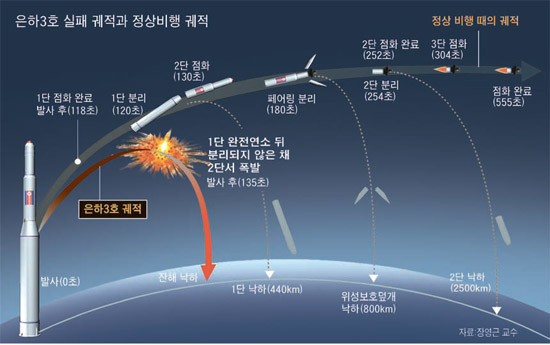North rocket didn’t separate: Expert


The rocket, fired from the North’s new launch site in the country’s northwestern Tongchang-ri area on April 13, exploded around two minutes after liftoff and separated into around 20 pieces before sending its debris down to the sea around 100 to 150 kilometers (62 to 93 miles) off the South’s west coast.
After the failed rocket launch, the defense ministry said that a defect in the first-stage engine caused the explosion of the first-stage propellant and blew up the whole rocket. The ministry said the rocket reached an altitude of 151 kilometers before starting to fall.
But Chang’s analysis suggested that the first-stage engine fired without any problems. The problem, he said, rather came in the next process of the first-stage propellant’s separation from the rest of the rocket. As the second-stage rocket ignited, it exploded because the first-stage rocket was still connected to it, he said.
The professor estimated that the first-stage engine completed combustion 118 seconds after liftoff. It was then supposed to disconnect in the next two seconds, which it didn’t, as the second-stage rocket began combustion 130 seconds after blastoff. The ministry has said the explosion came 135 seconds after liftoff.
Chang claims the computer simulation he used is more precise than that of the defense ministry.
Under the simulation, assuming it was a separation problem, not a defect in the first engine, the debris of the rockets from the explosion fell in the sea off Pyeongtaek and Gunsan, around 400 kilometers away from Tongchang-ri launch base, where the actual debris was estimated to have fallen.
If the first-stage propellant had been separated properly, it would have fallen in the sea off Byeonsan Peninsula, about 410 kilometers to 470 kilometers from Tongchang-ri, the simulation showed.
By Park Bang-ju [joe@joongang.co.kr]










with the Korea JoongAng Daily
To write comments, please log in to one of the accounts.
Standards Board Policy (0/250자)